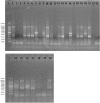Assessment of Mineral Nutrient Efficiency in Genetically Diverse Spinach Accessions by Biochemical and Functional Marker Strategies
- PMID: 35707614
- PMCID: PMC9189916
- DOI: 10.3389/fpls.2022.889604
Assessment of Mineral Nutrient Efficiency in Genetically Diverse Spinach Accessions by Biochemical and Functional Marker Strategies
Abstract
Leafy vegetable crops are considered as a natural source of mineral nutrients that could decrease the risk factor of many growth issues in children and adults. Spinach is globally considered as the most desirable leafy crop, due to its taste and nutrient richness along with greater nitrate contents and better nitrogen use efficiency. To evaluate the mineral nutrient efficiency of this crop, thirty genetically diverse spinach accessions were analyzed through nutritional and functional marker strategies. The accession 163,310 from Pakistan was found to be rich in minerals (sodium, calcium, potassium, zinc, and manganese) and nitrates. However, the oxalate contents were lesser in the accessions that had greater quantity of nutrients. These represented a negative correlation between mineral availability and oxalate accumulation in the leaves. To study the relationship of oxalates and minerals in the accessions, a functional marker analysis was performed, based on the genes involved in oxalate metabolism and disease resistance in spinach. High level of genetic polymorphism was observed among the accessions represented with 115 polymorphic bands out of 130 bands. Heat map clustering represented the accessions from Asian countries (Pakistan, India, China, and Iran) as the most adaptable accessions to the local environment. The correlation between nutritional and genetic analysis also revealed the nutrient richness of these accessions along with good oxalate metabolism and disease resistance. Hence, these accessions could be considered as useful genotypes in future breeding programs.
Keywords: accession; breeding; crop improvement; mineral uptake; nitrate; oxalate; spinach.
Copyright © 2022 Rashid, Yousaf, Din, Munawar, Aftab, Riaz, Younas, Alaraidh, Okla and AbdElgawad.
Conflict of interest statement
The authors declare that the research was conducted in the absence of any commercial or financial relationships that could be construed as a potential conflict of interest.
Figures




Similar articles
-
Genetic diversity and association mapping of mineral element concentrations in spinach leaves.BMC Genomics. 2017 Dec 4;18(1):941. doi: 10.1186/s12864-017-4297-y. BMC Genomics. 2017. PMID: 29202697 Free PMC article.
-
A Genome-Wide Association Study Reveals the Genetic Mechanisms of Nutrient Accumulation in Spinach.Genes (Basel). 2024 Jan 28;15(2):172. doi: 10.3390/genes15020172. Genes (Basel). 2024. PMID: 38397162 Free PMC article.
-
Ammonium reduces oxalate accumulation in different spinach (Spinacia oleracea L.) genotypes by inhibiting root uptake of nitrate.Food Chem. 2015 Nov 1;186:312-8. doi: 10.1016/j.foodchem.2014.06.122. Epub 2014 Jul 10. Food Chem. 2015. PMID: 25976827
-
Dissection of Crop Metabolome Responses to Nitrogen, Phosphorus, Potassium, and Other Nutrient Deficiencies.Int J Mol Sci. 2022 Aug 13;23(16):9079. doi: 10.3390/ijms23169079. Int J Mol Sci. 2022. PMID: 36012343 Free PMC article. Review.
-
Breeding crops for improved mineral nutrition under climate change conditions.J Exp Bot. 2015 Jun;66(12):3511-21. doi: 10.1093/jxb/eru539. Epub 2015 Jan 22. J Exp Bot. 2015. PMID: 25614661 Review.
Cited by
-
Improvement of crop production in controlled environment agriculture through breeding.Front Plant Sci. 2025 Jan 27;15:1524601. doi: 10.3389/fpls.2024.1524601. eCollection 2024. Front Plant Sci. 2025. PMID: 39931334 Free PMC article. Review.
-
The Effects of Claw Health and Bone Mineral Density on Lameness in Duroc Boars.Animals (Basel). 2023 Apr 28;13(9):1502. doi: 10.3390/ani13091502. Animals (Basel). 2023. PMID: 37174539 Free PMC article.
-
The Interplay of Sulfur and Selenium Enabling Variations in Micronutrient Accumulation in Red Spinach.Int J Mol Sci. 2023 Aug 14;24(16):12766. doi: 10.3390/ijms241612766. Int J Mol Sci. 2023. PMID: 37628947 Free PMC article.
-
How to Increase the Nutritional Quality of Stinging Nettle Through Controlled Plant Nutrition§.Food Technol Biotechnol. 2023 Dec;61(4):451-464. doi: 10.17113/ftb.61.04.23.8119. Food Technol Biotechnol. 2023. PMID: 38205052 Free PMC article.
References
-
- Abu Al-Qumboz M. N., Abu-Naser S. S. (2019). Spinach expert system: diseases and symptoms. Int. J. Acad. Inf. Syst. Res. 3 16–22.
-
- Amom T., Nongdam P. (2017). The use of molecular marker methods in plants: a review. Int. J. Curr. Res. Rev. 9 1–9.
-
- Anon (1970). Oxygen Bomb Calorimetry and Combustion Methods. Manual No. 130. Moline, IL: Parr Instrument Co.
-
- AOAC (1990). Official Methods of Analysis. Association of Analytical Chemists, 15th Edn. Washington, DC: AOAC.
LinkOut - more resources
Full Text Sources

